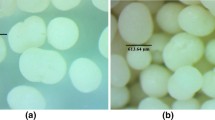Abstract
To study the controlled effect of poly (lactic acid) (PLA), poly lactic-co-glycolic (PLGA) and ethylenediamine (EDA)-maleic anhydride (MAH) modified PLA (EMPLA) for in vitro release of nestorone, rods were prepared using the solvent evaporation method. Amount of drug release in vitro was determined by UV spectrophotometry. Effects of rods diameter, the molecular weight of PLA, the drug percentage and the hydrophilicity of polymers on the release of biodegradable nestorone rods in vitro were investigated. It is indicated that the controlled effect of the biodegradable rods for the release of nestorone in vitro is good. The amount of drug released every week from rods in different diameter is similar to one another. The amount of drug released every week and the accumulative drug released during 12 week were almost in direct proportion with the drug percentage of the rods. The amount of drug released every week is increased as the decreasing of PLA molecular weight. As the hydrophlicity of polymer is improved, the rate of drug release every week is accelerated. The studies show that the plausibility of controlled release of nestorone from PLA, PLGA and EMPLA rods imply the possibility of their application as a controlled delivery system for nestorone. The results show that the greater the molecular weight of PLA is, the slower its degradation is and the slower the drug released; the greater the percentage of nestorone is, the more quickly the drug release. An increase of the hydrophilicity of the polymers will increase their degradation rate and leads to a fast drug release. Anyhow, these rods systems should be further evaluated in vivo.
Similar content being viewed by others
References
E M Countinho, A R Dasilva. Fertility Control with Sub-dermal Silastic Capsules Containing a New Progestin (ST-1435) [J]. Int. J. Fertil, 1976, 21: 103–108
P L A Lahteenmaki. Intestinal Absorption of ST-1435 in Rats[J]. Contraception, 1984, 30(2): 143–151
H B Croxatto. Progestin Implants for Female[J]. Contraception, 2002, 65: 15–19
H B Croxatto. Progestin Implants[J]. Steroids, 2000, 65: 681–685
I Sivina, H B Croxatto, L Bahamondes, et al. Two-year Performance of a Nestorone®-releasing Contraceptive Implant: A Three-center Study of 300 Women[J]. Contraception, 2004, 69: 137–144
C H Liu. Clinical Study on Bio-degradable Sub-dermal Implants for Contraception[J]. Chinese J. Family Planning, 1996, 23(3): 187–189
J Ren, J X Song. Research and Applications on Polylactide and Its Copolymers in Drug Delayed Release System[J]. J. Tongji University, 2003, 31(9): 1 051–1 057
Ai H Jin, Y G Zhang, J J Jiao, et al. Studies on the Toxicity of Polymer of Glycolide and Sactide(PLGA) and the Anti-fertility Effect of Sevonorgestrel(LNG)[J]. J. Biomedical Engineering, 2000, 17(2): 125–128
D Sendil, D Wise, V Hasirci. Assessment of Biodegradable Controlled Release Rod Systems for Pain Relief Applications[ J]. J. Biomater. Sci. Polymer. Edn., 2002, 13(1): 1–15
R P Batycky, J Hanes, R Langer, et al. A Theoretical Model of Erosion and Macromolecular Release from Biodegrading Microspheres[J]. J. Pharm. Sci., 1997, 86(12):1 464–1 477
T G Park. Degradation of Poly(D,L-Lactic acid) Microspheres: Effect of Molecular Weight[J]. J. Control. Release, 1994, 31: 161–173
R Jalil, J R Nixon. Microencapsulation Using Poly (D,L-lactic Acid) III: Effect of Polymer Molecular Weight on the Release Kinetics[J]. J. Microencapsul, 1990, 7: 357–374
S Li. Hydrolytic Degradation Characteristics of Aliphatic Polyesters Derived from Lactic and Glycolic Acids[J]. J. Biomed. Mater. Res.: Appl. Biomat., 1999, 48: 342–353
A Gopferich. Polymer Degradation and Erosion: Mechanisms and Application[J]. Eru. J. Pharm. Biopharm., 1996, 42: 1–11
Author information
Authors and Affiliations
Corresponding author
Rights and permissions
About this article
Cite this article
Cao, C., Zhu, F., Wang, Q. et al. Release of nestorone from biodegradable rods system in vitro . J. Wuhan Univ. Technol.-Mat. Sci. Edit. 25, 4–7 (2010). https://doi.org/10.1007/s11595-010-1004-0
Received:
Accepted:
Published:
Issue Date:
DOI: https://doi.org/10.1007/s11595-010-1004-0




